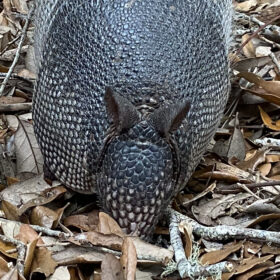
These days it seems like armadillos are everywhere, in all-natural areas on this island snuffling around in the duff of the forest floor and in our yards as well. They are nearsighted and nearly deaf, so it’s easy to get close to them to investigate if you are upwind of them. But if they smell you or you make sudden moves they notice you and run off into the brush. Supposedly if startled they can jump straight up, which may help them escape people, bears, bobcats and what have you, but this is a death sentence when vehicles are involved. Just look at the road kills around here and you can see what I mean.
Just a few decades ago we didn’t have armadillos in Florida. I remember one of my professors at the University of Florida in 1984, Dr. Archie Carr of sea turtle fame, who led us grad students to ecosystems all around Florida. Whenever we saw signs of armadillo rooting he got livid. “These are invaders! Armadillos don’t belong here! They’re destroying native species and habitats! They disturb the soil and eat everything including small reptiles, eggs, pupae, etc. that are important parts of the natural food chain.” Archie hated armadillos. During his long life as a Florida naturalist, he was among the first to notice the armadillo invasion and he did his best to alert everyone to the consequences.

How armadillos got here is a mixed story. Armadillos arrived on the Florida peninsula in the 1920s and 1930s from escaped captive populations in Titusville and Dade County and, with few natural predators (Florida panthers, bobcats, bears), the population quickly expanded north and west. Meanwhile, a natural population of armadillos from Latin America expanded into Texas and headed our way too. Although the zoo escapees and their offspring were considered an “alien invasive species” back in Archie’s time the fact that others moved in on their own from wild populations to the west of us just makes them strong natural competitors. And, as such, they belong here as much as any other animal that extends its home range. With the climate changing there are many more such examples now.
Armadillos do indeed dig up the ground in their search for insects, worms and other soil-dwelling food sources and this does disturb the habitat. But the ecology of our area will adapt to these changes. And, many people actually enjoy watching armadillos. If you come here from points further north, often armadillos are the first unusual animal that you encounter. Armadillos along the roads of Fort Clinch State Park draw their share of gawkers, with cameras aimed, recording them for the folks back home.
That’s great for these visitors who don’t have to live with armadillos in their backyards like many of us do. If you have holes being dug next to the foundation of your house or under your patios and fences you know what I mean. You can fill and refill these armadillo burrows, and the persistent creatures will keep digging them up again. You can annoy them by shining lights into their burrows, or putting noisemakers there, or trying mostly useless repellents but then they’ll just move somewhere else in your yard and make more holes. They are also very difficult to trap. Sometimes the only solution is to bring in a registered pest control company to capture your armadillos and remove them, at great cost to you.

Like most species on earth, though, armadillos are useful to humans in various ways. For one thing, if you aren’t squeamish you can eat them. A fellow grad student friend of mine used to pick up armadillo road kills and turn their hard carapace into helmets, which he sold to somebody or another; there’s no accounting for tastes. Some local communities, like the Gullahs on Sapelo Island, even made baskets from armadillos.
Armadillos are also a genetic anomaly. They always have four identical young of the same sex, originating from a single egg. From birth on they look about the same as adults, just smaller, and males and females are difficult to tell apart unless you’re holding one and examine it carefully. (But they can carry leprosy, so this is not recommended).

Instead of detesting armadillos, as Archie Carr taught me, I’ve made my peace with them. When I see them I admire their primitive form and their oblivion to all that is around them, as they root in the soil close to people and traffic. Our roads are littered with dead armadillos, but that provides food for our vulture population. At least, unlike us humans, armadillos do not seem to be worried about their future as they go along with their dangerous life. And, you’ve got to respect them for that!
Pat Foster-Turley, Ph.D., is a zoologist on Amelia Island. She welcomes your nature questions and observations. [email protected]

Thanks for this informative post Pat! When I came to Florida in 1975 and was doing my first “Folk Arts Survey” for the state, I conducted several oral histories with retired circus folks in Sarasota. The story I heard many times was that armadillos came to Florida with the Ringling Brothers show, in a traveling zoo that was part of the circus. Ringling and other circus folks wintered in south Florida (Sarasota to Gibsonton). Somehow, one winter the armadillos made a break for it . . . and the rest is history. Of course, this is folklore too!
A story circulated years ago about a Texan driving to Michigan who picked up road-kill armadillos as he went. arriving in Michigan, he tossed the armadillos out on local roads resulting in a news story that armadillos had invaded Michigan.